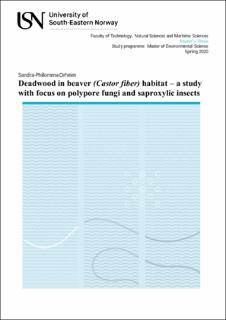Deadwood in beaver (Castor fiber) habitat – a study with focus on polypore fungi and saproxylic insects
Master thesis
Published version
Permanent lenke
https://hdl.handle.net/11250/2721949Utgivelsesdato
2020Metadata
Vis full innførselSamlinger
Sammendrag
Deadwood is known as a diversity indicator in a forest, where 20-25 % of all forest species in the Nordic countries are dependent on deadwood. 10.7 % of the saproxylic beetles in Europe and 37 % of the polypore fungi in Finland is threatened, and forestry is a big threat. This study surveys to what extent the Eurasian beaver (Castor fiber) affects the number of available deadwood objects and the presence of polypore fungi- and saproxylic insect. The presence of saproxylic insects and polypore fungi is also surveyed up against several environmental factors to detect potential effects. The study was conducted by Gvarv and Saua river in Vestfold og Telemark county in Southeastern Norway in August and September 2019. Saproxylic insects and polypore fungi were registered together with several environmental variables in transects perpendicular on the riversides. For the polypore presence my results indicated a higher presence on both laying- and standing deadwood compared to stumps. My results also indicated a higher presence for later decomposition stages, and a positive effect of bark cover and tree diameter. For the presence of saproxylic insects my results indicated a higher presence in later decomposition stages. The death cause of the tree (beaver cut, human cut, natural death cause) was not found informative in describing the presence of neither saproxylic insects not polypore fungi. The deadwood will most likely not be very different independent of what caused the death of the tree. According to this study it does not seem like neither the presence of saproxylic insects or polypore fungi are directly affected by the fact that a beaver cut down the tree compared to a human or a natural death cause. However, the beaver might have an indirect effect in the long term.
